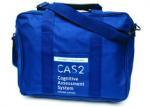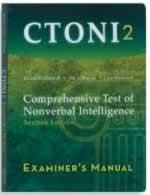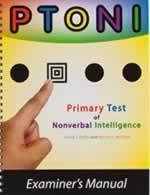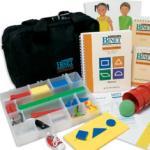SB5 Stanford-Binet Intelligence Scales Fifth Edition
Interest Level:
CHOKING HAZARD(1).
Not for < 3 yrs.
Not for < 3 yrs.
Additional Components:
Test, Manual, Manipulatives, Subtests, Routing Forms and Training Resources
This product requires a check of customer qualifications.
CLICK HERE to download qualifications form.
Widely known as the standard for intelligence measurement since 1916. Times: Approximately 5 minutes for each of 10 subtests Administration: Individual The Stanford-Binet Intelligence Scales Fifth Edition (SB5) is a collection of 10 subtests, providing Nonverbal, Verbal, and Full Scale IQ scores and other diagnostic indexes, offers highly reliable assessment of intellectual and cognitive abilities, based on a large normative sample of 4,800 individuals, ages 2 to 85+. Under the...
Widely known as the standard for intelligence measurement since 1916.
Times: Approximately 5 minutes for each of 10 subtests
Administration: Individual
The Stanford-Binet Intelligence Scales Fifth Edition (SB5) is a collection of 10 subtests, providing Nonverbal, Verbal, and Full Scale IQ scores and other diagnostic indexes, offers highly reliable assessment of intellectual and cognitive abilities, based on a large normative sample of 4,800 individuals, ages 2 to 85+. Under the requirements of the Individuals with Disabilities Education and Improvement Act (IDEIA, 2004), the SB5 provides a comprehensive profile of scores to document the cognitive strengths and weaknesses of children, adolescents, and adults with learning difficulties, delays, and disabilities.
Features and Benefits
- One kit covers the full age range of 2 years to 85+ (no 2nd or 3rd kits required)
- One half of the test has nonverbal content that requires no (or minimal) verbal responses from the examinee
- Pairs of SB5 subtests measure five cognitive factors- Fluid Reasoning, Knowledge, Quantitative, Visual-Spatial, and Working Memory- more than other competing IQ measures.
- The 5 subtests in the Nonverbal section are useful in assessing individuals with Limited English Proficiency, deaf and hard of hearing conditions, nonverbal learning disabilities, ADHD, traumatic brain injury, and autistics spectrum disorders
- SB5 is one of the major instruments in assessment of intellectual giftedness and extensive high-end items are included to ensure measurement of high levels of gifted performance
- SB5 also measures low levels of intellectual functioning because it includes many toys and improved low-end items for better measurement in the low functioning range
- Valid measurement of abilities into the elderly years is provided by enhanced assessment of memory
- Modernized artwork and item content were included
- Child-friendly manipulatives make the SB5 a popular choice for preschool testing
- The SB5 is easy for examiners to learn and administer
Materials and Test Administration
The SB5 has a display box filled with blocks, toys, chips, and other manipulatives that engage the attention of children and examinees of all ages. The test is easy to learn because it is administered in an easel format- with three 9 by 6 Item Books that fold into an A-frame easel. Each page of the Item Books has illustrations on one side for the examinee and detailed directions for the examiner on the other side. Each item has the spoken directions that examiners read in boldface type, along with other directions for using manipulatives, scoring guidelines, and correct answers. So, examiners do not need a separate manual to read while arranging stimuli and manipulatives. The Item Books include the following:
- Item Book 1 has the Matrices and Vocabulary subtests used as the initial assessment or Abbreviated Battery IQ
- Item Book 2 has the nonverbal subtests, arranged according to levels of difficulty, from Level 1 to 6- used to adapt the test to the examinee s ability (based on the initial Matrices subtest of Item Book 1). These levels are clearly marked with a colored border on the bottom of the pages. Levels allow the test to be tailored to the examinee s ability, saving time and making the assessment accurate and reliable.
- Item Book 2 has the verbal subtests, again arranged in levels of difficulty. The examinee begins at the level suggested by the Vocabulary subtest in Item Book 1.
The Record Form was designed to match the widely used format of other IQ tests and guides the examiner through the initial subtests, the Nonverbal sections, and Verbal sections in that order.
Scoring and Interpretation
The SB5 can be hand-scored or scored with the optional SB5 Online Scoring and Report System. The scaled scores for the ten subtest scores are the familiar profile scores used in other IQ measures---with a mean of 10, and Standard Deviation of 3 (range 1-19). These subtest scores combine to form four types of composite scores: 5 factor indexes (Fluid, Knowledge, Quantitative, Visual-Spatial, and Working Memory), 2 domains (Verbal and Nonverbal), Brief IQ from 2 subtests, and Full Scale (each with scaled score means of 100, SD=15 (range 40-160)). Two subtests (one verbal and one nonverbal) combine to form each of the 5 factor indexes. There are two domain scales: Nonverbal IQ (combines the five nonverbal subtests) and Verbal IQ (combines the five verbal subtests). Two initial subtests combine to form the Abbreviated Battery IQ. Finally, the Full Scale IQ combines all ten subtests.
The Examiner s Manual provides detailed suggestions for interpretation of subtest and composite scores, tables of norms, and additional interpretive guidelines. Supplemental interpretive tables and indexes are included in the Technical Manual and Supplemental Interpretive Manual. The scoring software automates the interpretive process by displaying narrative descriptions of scores and graphic profiles, along with identification of significant score differences.
Statistical Characteristics of the SB5
Normative data for the SB5 were gathered from 4,800 individuals between the ages of 2 and 85+ years. The normative sample closely matches the 2000 U.S. Census (education level based on 1999 data). Bias reviews were conducted on all items for the following variables: gender, ethnicity, cultural, religion, region, and socio-economic status. Additionally, the SB5 was co-normed with the Bender-Gestalt Visual-Motor Gestalt Test, 2nd Edition and linked to the Woodcock-Johnson Tests of Achievement.
Reliabilities for the SB5 are very high. For the FSIQ, NVIQ, and VIQ, reliabilities range from .95 to .98 (average internal consistency composite reliability, across all age groups). Reliabilities for the Factor Indexes range from .90 to .92. For the ten subtests, reliabilities range from .84 to .89.
Extensive validity studies were conducted, including clinical-group differences, correlations with other tests, age trends, factor structure, and consequential validity. Many of these studies are presented in the Technical Manual and others in the Supplemental Interpretive Manual.
Supplemental Interpretive Manual
The Interpretive Manual provides detailed guidelines for the effective interpretation of the SB5 for a number of applications, including its use by psychologists active in school, clinical, and counseling settings. Case studies, profile analyses, and SB5 Scoring Pro reports provide concrete examples of interpretation. This manual also introduces an Extended IQ (EXIQ) scale that supports the calculation of Full Scale IQ scores substantially lower than 40 (e.g., to an IQ of 10) or higher than 160 (to an IQ of 225).
Technical Features
The SB5 blends many of the important features of earlier editions with significant improvements in psychometric design. Modern item response theory provides a strong psychometric foundation for the routing, subtests, and functional-level design. The 2 subtests in Item Book 1 allow the remainder of the test to be adapted to the examinees estimate ability level. Research has shown that adapting the test to the functional level of the examinee increases the precision of measurement by tailoring the difficulty of the items to examinee levels, and saves time by allowing more cognitive tasks to be covered in the same time period.
Optional Change-Sensitive Scores (CSSs) use modern item response theory scaling to convert the raw scores into criterion-referenced scores- anchored to age levels and the complexity of the items at each score level. These scores, as with norm-referenced scores, have excellent measurement properties. Because the CSSs measure absolute (across age) levels of ability, they provide a means to compare changes in an individual's scores over time. Relatively small gains or losses in intellectual ability can be tracked using CSSs across time with students in special education. Parents and guardians of individuals with special needs will appreciate the straight-forward information that will be identified with changes in CSSs over time. In contrast, when normative scores such as percentiles are used instead of CSSs, changes across years are often hidden because the individual with special needs often lags behind age peers and does not catch up when normative scores are used alone.
University Training Resources
The SB5 University Training Resources contains a CD-ROM with a PowerPoint presentation, along with PDF documents for Tips for Examiners, Frequently Asked Questions, selected Assessment Service Bulletins, and other resources. This package is designed for use by university professors and training professionals to help teach others the use of the SB5 .
COMPLETE SB5 (©2003) KIT INCLUDES:
- Examiner s Manual
- Technical Manual
- Item Book 1 (Routing Subtest)
- Item Book 2 (Nonverbal Subtest)
- Item Book 3 (Verbal Subtest)
- 25 Record Forms
- and Manipulatives
- all in a sturdy canvas carrying case.
Buyer Qualifications:
To administer this test at least a master s degree is required, with state licensure OR certification from a professional organization (ASHA, AOTA, APA, AERA, ACA, AMA, NASP, NAN, INS) that requires formal training and experience in ethics, psychometrics, statistics, and scoring and interpretation and/or a doctoral degree in psychology, education, or a closely related field. These tests are usually considered sensitive and assess intellectual and/or personality characteristics for clinical diagnostic purposes. All test users, regardless of level and profession, are expected to abide by the standards set forth by the APA, AERA and NCME regarding the ethical use, protection and dissemination of all test materials. All orders for the products listed below, must be placed on official institutional purchase order forms or professional letterhead.
The purchase of this product requires a check of customer qualifications.
CLICK HERE to download qualifications form.
Orders for items on this page cannot be completed online. Please attach completed qualifications form to your institutional purchase order or professional letterhead when ordering this product. For questions or help placing your order for these items call (800) 880-4433.
To create a requistion form
- Enter a Quantitiy for the item(s) desired
- Click Add to Cart
- Click Print a requisition list
Item #
Products
Price
Wishlist
Qty
Requested quantity is not available at this time
YP1161YY
SB5: Complete Kit
$1450.00
Requested quantity is not available at this time
YP1162YY
SB5: Manipulatives Kit
$335.00
Requested quantity is not available at this time
YP1164YY
SB5: Complete Test Kit and Interpretive Manual
$1550.00
Requested quantity is not available at this time
YP1165YY
SB5: Examiner's Manual
$195.00
Requested quantity is not available at this time
YP1166YY
SB5: Interpretive Manual
$165.00
Requested quantity is not available at this time
YP1167YY
SB5: Item Book 1 (Routing Subtests)
$280.00
Requested quantity is not available at this time
YP1168YY
SB5: Item Book 2 (Nonverbal Subtests)
$280.00
Requested quantity is not available at this time
YP1169YY
SB5: Item Book 3 (Verbal Subtests)
$280.00
Requested quantity is not available at this time
YP1170YY
SB5: Record Forms (25)
$130.00
Requested quantity is not available at this time
YP1171YY
SB5: Technical Manual
$195.00
Requested quantity is not available at this time
YP1172YY
SB5: University Training Recourses CD
$67.00
Requested quantity is not available at this time
YP1181YY
Early SB5: Early Childhood Stanford-Binet Intelligence Scales Fifth Edition Complete Kit
$545.00
Requested quantity is not available at this time
YP1183YY
Early SB5: Examiner's Manual
$94.00
Requested quantity is not available at this time
YP1184YY
Early SB5: Item Book 1
$265.00
Requested quantity is not available at this time
YP1185YY
Early SB5: Item Book 2
$265.00
Requested quantity is not available at this time
YP1186YY
Early SB5: Record Forms (25)
$100.00
Only the first 5 items are displayed. Click here to
See all items




